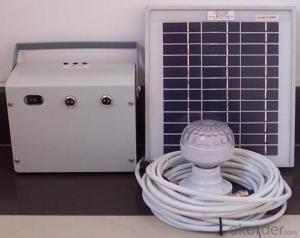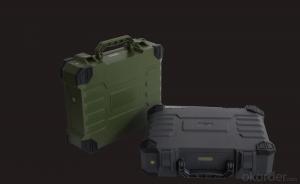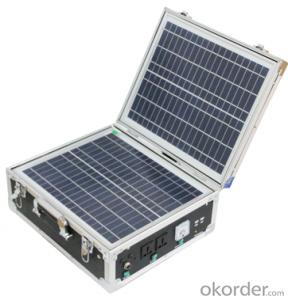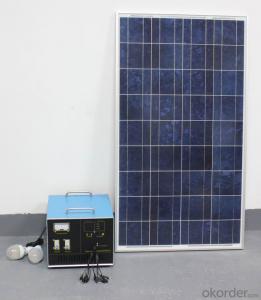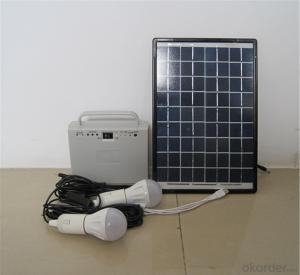Solar Portable System AN-S50W
- Loading Port:
- Shanghai
- Payment Terms:
- TT OR LC
- Min Order Qty:
- 0 set
- Supply Capability:
- 10000 set/month
OKorder Service Pledge
OKorder Financial Service
You Might Also Like
Item specifice
Description of Solar Portable System AN-S50W
Compatible portable solar power supply, also called solar mobile power, it includes: solar panel, charge controller, discharge controller, electric charge controller, inverter, outside enlarge capacity interface and battery, etc. Photovoltaic portable power supply can work in solar energy and ordinary power two modes, and can automatically switch. Photovoltaic portable power supply is used widely is the emergency relief, tourism, army, geological prospecting, archaeology, schools, hospitals, Banks, gas stations, comprehensive building, highway, substation, family camping or outdoor activities such as emergency power ideal power supply equipment.
Specifications of Solar Portable System AN-S50W
1. Solar Panel: 50W 18V
2. Battery: 12V20AH lead-acid battery
Input terminal: 1 DC input, 14.8V; 2 solar input terminal (+,-), 18V.
Output terminal: 8 output terminals, including:
1x USB output, 5V 1A;
5x DC outputs, 12V 1A;
2xAC220V outputs
Switch: 2pcs; left one for DC12V, right one for AC220V
Indication lamp: 2 pcs; Red one is for charging indication, Green one is for operating indication.
Accessories of Solar Portable System AN-S50W
1. 2pcs 3W led bulbs;
2. 1pc 5m connection wire between solar panel and cabinet;
3. 2pcs lamp holder with 3m wire;
4. 1pc AC charger
Technical Data of Solar Portable System AN-S50W
| Internal Package Size (cm) | 36*24*26 (panel extra) |
| Packing QTY | 1 |
| External Package Size (cm) | 36*24*26 (panel extra) |
IMages of Solar Portable System AN-S50W
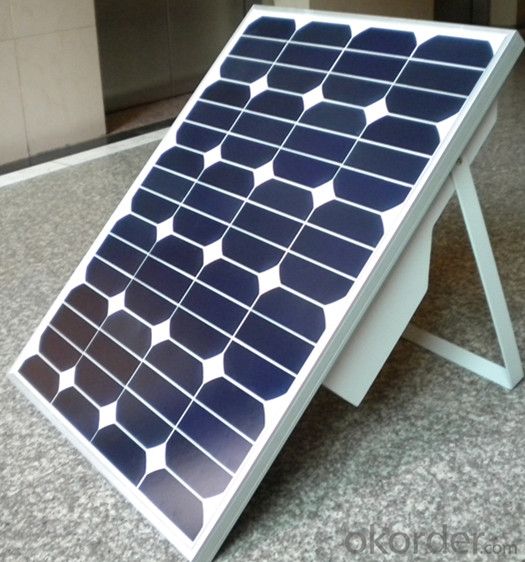

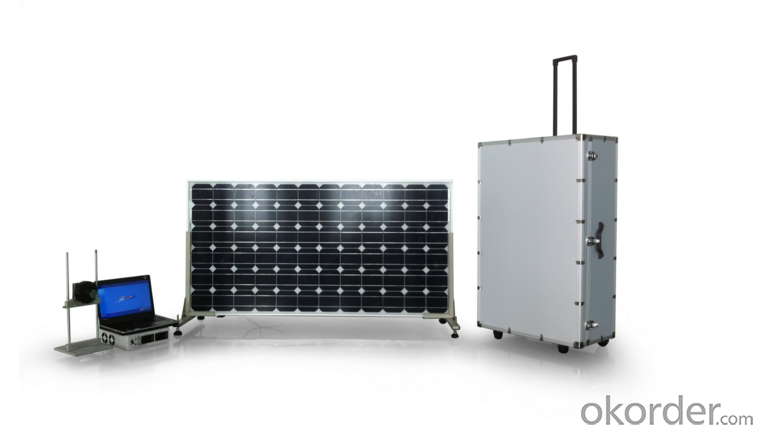
FAQ:
1. How long will my inquiry get response?
Your inquiry related to our products or prices will be replied within 24 hours.
2. Can I get professional service and suggestion?
Well-trained and experienced staffs to answer all your questions in fluent English.
3. Do you accept OEM or customized design?
OEM & ODM, any your customized lightings we can help you to design and put into product.
4. What if I need specific design?
Distributorship are offered for your unique design and some our current models.
- Q:How much space is needed for installing a solar energy system?
- The amount of space needed for installing a solar energy system depends on various factors such as the size and type of the system, the energy requirements, and the available sunlight. Generally, a small residential solar energy system can be installed on rooftops or in a backyard with an area of about 100-400 square feet, while larger systems for commercial or industrial use may require several acres of land. It is important to conduct a site assessment to determine the suitable space for installation based on individual needs and local conditions.
- Q:How does a solar thermal system convert sunlight into heat?
- A solar thermal system converts sunlight into heat through the use of solar collectors or panels. These collectors, typically located on a roof or mounted on the ground, are designed to absorb and capture the sun's energy. They contain a fluid, usually water or a heat transfer fluid, that is heated as it circulates through the collectors. The absorbed heat is then transferred to a storage tank or used directly for various heating applications, such as heating water for domestic use or providing space heating in buildings.
- Q:What is solar tracking and how does it improve system efficiency?
- Solar tracking is a mechanism used in solar energy systems to orient solar panels towards the sun, maximizing their exposure to sunlight throughout the day. By continuously adjusting the position of the solar panels, solar tracking ensures that the panels are always perpendicular to the sun's rays, increasing the amount of solar energy captured. This improved alignment significantly enhances system efficiency as it allows for a higher solar energy input, resulting in increased electricity production and overall better performance of the solar energy system.
- Q:How long does it take to recoup the cost of installing a solar energy system?
- The time it takes to recover the cost of installing a solar energy system can vary due to different factors, such as the initial system cost, electricity generation, and grid electricity expenses. Typically, it takes about 5 to 10 years to recoup the initial investment of a solar energy system. However, this duration can be shorter or longer depending on specific circumstances. The payback period is influenced by various factors, including the cost of grid electricity. Higher electricity prices result in a larger offset of the electricity bill by the solar system, leading to quicker payback. Government incentives and tax credits can also reduce the initial cost and shorten the payback period. The amount of electricity generated by the solar system is crucial as well. A larger system that generates more electricity will offset a greater portion of the electricity bill, accelerating the payback period. Location and local climate are additional considerations. Regions with abundant sunlight and higher electricity costs tend to have shorter payback periods. Net metering programs, which allow excess energy to be sold back to the grid, can further reduce the time it takes to recover the investment. It's important to note that the payback period is only one factor to consider when assessing the financial feasibility of a solar energy system. These systems have long lifespans, typically lasting 25 to 30 years, during which they continue to generate free and clean electricity, offering significant savings and environmental benefits beyond the payback period.
- Q:Can solar panels be installed on different surfaces like glass or metal?
- Yes, solar panels can be installed on different surfaces like glass or metal. In fact, solar panels are commonly installed on glass surfaces, such as windows or skylights, to maximize sunlight exposure. Additionally, solar panels can also be mounted on metal roofs or other metal structures. The key requirement is ensuring a sturdy and secure installation to support the weight of the panels and maximize their efficiency.
- Q:Can solar energy systems be financed or leased?
- Yes, solar energy systems can be financed or leased. Many companies and financial institutions offer financing options to make solar energy systems more affordable for homeowners and businesses. Leasing is another popular option where the solar panels are owned and maintained by a third-party company, allowing customers to benefit from the energy generated without the upfront costs of purchasing the system.
- Q:Can solar energy systems be installed in areas with heavy snowfall?
- Yes, solar energy systems can be installed in areas with heavy snowfall. However, it is important to consider the impact of snow on the system's performance and take necessary precautions during installation. Snow can temporarily reduce the amount of sunlight reaching the solar panels, which in turn reduces their energy production. However, the panels are designed to have a tilt and smooth surface, allowing snow to slide off easily. Additionally, advancements in technology have led to the development of snow-resistant solar panels that are more effective at converting sunlight into electricity even in snowy conditions. It is also worth noting that solar panels are often mounted at an angle to maximize their exposure to the sun, which helps to minimize snow accumulation. Overall, while heavy snowfall may impact the efficiency of solar energy systems, they can still be successfully installed and can contribute to renewable energy generation in areas with such climatic conditions.
- Q:Can solar energy systems be leased or financed?
- Yes, solar energy systems can be leased or financed. Leasing allows homeowners or businesses to use solar panels without owning them, while financing options such as loans or power purchase agreements (PPAs) provide a way to pay for solar installations over time. This makes solar energy more accessible and affordable for a wider range of people and organizations.
- Q:Are there any financing options available for purchasing solar energy systems?
- There exists a range of financing options for the acquisition of solar energy systems. One frequently utilized option entails obtaining a solar loan, which permits homeowners to borrow money specifically for the purpose of purchasing and installing a solar energy system. These loans generally present low interest rates and flexible repayment terms, rendering them an economical choice for many homeowners. An alternative financing option involves leasing a solar energy system. Through a solar lease, homeowners can have a solar energy system installed on their property without the need to pay for the equipment upfront. Instead, they make monthly lease payments to the solar company in exchange for utilizing the solar energy generated by the system. This option proves particularly popular among homeowners who prefer not to bear the responsibility of maintaining and repairing the equipment themselves. Moreover, certain states and municipalities offer solar incentives and tax credits to help mitigate the cost of installing solar energy systems. These incentives may include grants, rebates, or tax credits that reduce the initial costs associated with purchasing and installing solar panels. It is crucial to research the available incentives in your area, as they can significantly decrease the overall expense of adopting solar energy. Lastly, some solar companies provide power purchase agreements (PPAs), wherein homeowners pay for the solar electricity they consume at a predetermined rate. This option enables homeowners to benefit from solar energy without incurring any upfront costs, as the solar company owns and maintains the equipment. While PPAs may be a suitable choice for certain homeowners, it is imperative to carefully scrutinize the terms and conditions before entering into a contract. In conclusion, a variety of financing options are at hand for homeowners seeking to purchase solar energy systems, rendering the transition to clean and renewable energy sources more accessible and affordable.
- Q:How do solar energy systems impact homeowners insurance rates?
- Solar energy systems can have an impact on homeowners insurance rates, but it largely depends on the insurance provider and the specific terms of the policy. In general, installing a solar energy system can increase the value of a home, which may result in higher insurance premiums since the replacement cost of the property is higher. However, many insurance companies offer discounts or incentives for homeowners with solar panels, as these systems are considered to be a positive feature that reduces the risk of property damage and lowers energy costs. Additionally, some policies may include coverage for the solar panels themselves, protecting the homeowner from any potential damage or theft. It is important for homeowners to review their insurance policy and discuss any changes with their insurance provider to fully understand how the installation of a solar energy system may impact their rates and coverage.
1. Manufacturer Overview |
|
|---|---|
| Location | |
| Year Established | |
| Annual Output Value | |
| Main Markets | |
| Company Certifications | |
2. Manufacturer Certificates |
|
|---|---|
| a) Certification Name | |
| Range | |
| Reference | |
| Validity Period | |
3. Manufacturer Capability |
|
|---|---|
| a)Trade Capacity | |
| Nearest Port | |
| Export Percentage | |
| No.of Employees in Trade Department | |
| Language Spoken: | |
| b)Factory Information | |
| Factory Size: | |
| No. of Production Lines | |
| Contract Manufacturing | |
| Product Price Range | |
Send your message to us
Solar Portable System AN-S50W
- Loading Port:
- Shanghai
- Payment Terms:
- TT OR LC
- Min Order Qty:
- 0 set
- Supply Capability:
- 10000 set/month
OKorder Service Pledge
OKorder Financial Service
Similar products
New products
Hot products
Related keywords
